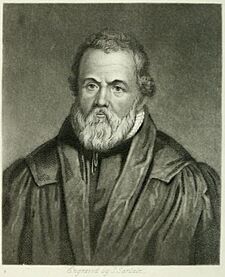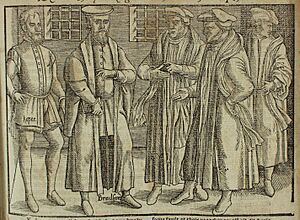John Bradford facts for kids
Quick facts for kids John Bradford |
|
 |
|
| Born | 1510 in Blackley, Manchester, England |
|---|---|
| Died | 1 July 1555 (age 44–45) in Smithfield, London, England |
| Church | Church of England |
| Education | Catharine Hall, University of Cambridge and Pembroke College, Cambridge |
| Ordained | 1550 |
| Offices held | Prebendary |
John Bradford (born 1510, died 1555) was an important English Reformer. He was a religious leader at St. Paul's in London. He is remembered as a martyr because of his strong beliefs. He was put in the Tower of London because of his religious views during the time of Queen Mary I. John Bradford was burned at the stake on July 1, 1555.
Contents
John Bradford's Early Life and Education

John Bradford was born in 1510 in a village called Blackley, near Manchester, England. He went to a grammar school and was very good with numbers and money. Later, he worked for Sir John Harington. John Bradford was very skilled at managing money and writing. This helped him gain his employer's trust.
During the wars of King Henry VIII, he worked as a paymaster for the English army. This was at the Siege of Montreuil in 1544. After this, he started studying law in London.
How Bradford Became a Protestant
While studying law, John Bradford learned about the Protestant faith. He became a Protestant himself. This changed his life path. In 1548, he stopped studying law. He decided to study theology, which is the study of religious faith. He went to Catharine Hall (now St Catharine's College) at the University of Cambridge.
In 1549, he earned his Master of Arts degree. In the same year, he became a fellow at Pembroke College, Cambridge.
Bradford's Work as a Preacher

At Cambridge, people often called him "Holy Bradford." This was not meant as an insult. It showed how much they respected his strong faith and kind nature. In August 1550, he became a deacon. Bishop Nicholas Ridley ordained him and made him his personal chaplain.
John Bradford began preaching in churches across London. He was guided by Bishop Ridley and Hugh Latimer. He was a very gifted preacher. In 1551, he was appointed as Chaplain to King Edward VI. He also became a Prebendary of St Paul's Cathedral. He continued to be a fellow at Pembroke College. He traveled and preached in London, Lancashire, and Cheshire.
Bradford's Imprisonment
After King Edward VI died in 1553, Mary I became queen. Queen Mary I brought back the rights and protections for Catholics in England. In her first month as queen, John Bradford was arrested. He was accused of trying to cause trouble and stir up a crowd. This was a serious charge at the time. He was sent to the Tower of London.
Even while in prison, John Bradford continued to write religious works. He also preached to anyone who would listen. For a time, he shared a cell in the Tower with three other important Reformers. These were Archbishop Thomas Cranmer, Bishop Ridley, and Hugh Latimer. They spent their time studying the New Testament together.
John Bradford's Death
On January 31, 1555, John Bradford was put on trial. He was found guilty and sentenced to death. He was taken to Newgate Prison. On July 1, he was taken to be burned at the stake.
Before his execution, a woman named Mrs. Marlet gave him a special "Shirt of Flame." This was a clean shirt made like a wedding shirt. It was a way for people to show support and honor him. It was like dressing him as a bridegroom for a wedding. This act also showed his strong faith.
A large crowd gathered to watch his execution. It was supposed to happen early in the morning, but the crowd delayed it. John Bradford was chained to the stake in Smithfield. A young man named John Leaf was also chained with him. Before the fire was lit, Bradford asked for forgiveness from anyone he had wronged. He also offered forgiveness to those who had wronged him. He then spoke to John Leaf, saying, "Be of good comfort brother; for we shall have a merry supper with the Lord this night!"
A century later, a writer named Thomas Fuller wrote about Bradford's death. He said that Bradford endured the flames "as a fresh gale of wind in a hot summer's day." This meant he faced his death bravely. His death confirmed the truth of the religious ideas he had preached.
John Bradford is remembered at the Marian Martyrs' Monument in Smithfield, London. There is also a statue of him on the outside of Manchester Town Hall. This statue honors his importance in the city's early history.
See also
- List of people burned as heretics
- Protestant Reformers

